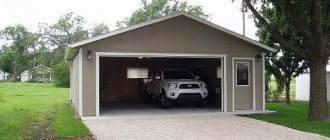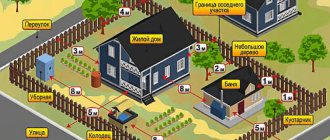All types of construction near existing roads in 2021 are controlled by law. The requirements relate to the following legal aspects:
- distance from home to road;
- from the roadway to children's institutions;
- construction near the railway.
Design of a settlement indicating the distances from buildings to the road
For houses in SNT, you must follow the rules for their location relative to the road. All norms and requirements for the construction of residential buildings are specified in SNiP. It is necessary to comply with the requirements of SNiP so that there are no misunderstandings with neighbors, or with the local administration, or with the fire department.
Distance from the road to the house in the private sector
Documents to be taken into account when planning buildings:
Indication on the site plan of the distances from buildings to the road
- Land Code;
- Building regulations;
- Set of rules for rural settlements;
- Set of rules for garden cooperatives.
Owners of their personal plots believe that the placement of a fence is their personal matter - this is a big misconception. The distance from the fence to the residential building is determined by the boundaries of the allotment.
Diagram indicating the distances from the house to the road on the site
The distance from the building to the street is regulated by article SNiP 30-02-97. But the distance from the fence to the roadway is not specified in SNiP. When installing a fence, you need to study the cadastral passport. The area of the land plot is indicated.
Drawing and layout of the site according to SNiPs
The minimum distance from the road to the fenced area is 5 meters. The boundaries of land plots are established by the local administration based on:
- building codes;
- fire safety standards;
- the required size of the sanitary area.
What is included in the area around an apartment building?
According to the Housing Code of the Russian Federation, it may include the following infrastructure facilities:
- the plot of land on which the house is built;
- green areas and other landscaping and landscaping elements;
- children's and sports grounds;
- places for parking and collective parking of vehicles;
- equipped places for drying clothes;
- electrical substations and transformers;
- individual garages and cellars, as well as special passages for fire equipment.
All of the above objects must be located within the local area.
How is landscaping usually done?
Permitted types of activities for landscaping adjacent areas include:
- arranging flower beds, lawns, planting low-growing shrubs and caring for them;
- production of iron fences for green areas;
- arrangement of balconies with boxes of flowers (they must correspond to the design of the house;
- installation of additional fasteners is possible only with permission).
When carrying out landscaping, the following are prohibited:
- landing;
- transfer;
- cutting and crowning of perennial trees, as well as dead wood.
IMPORTANT. Such work must be carried out by the relevant services, or by the residents themselves, but after obtaining the necessary permits from local authorities.
Landscaping work in areas that are in shared ownership is carried out with the money of the share owners.
What are the features of landscaping?
In addition to landscaping work, the improvement of adjacent areas includes the arrangement of children's and sports grounds , installation of fences, removal of snow and garbage and other work (read about the sanitary maintenance of the adjacent area of an apartment building here, and about who is responsible for cleaning, read here). At the same time, you should know that the placement of children's and sports grounds should be done as close as possible to the house itself , but at the same time it should not interfere with the free passage of cars, and also not block passages for firefighting and other special equipment.
The following types of fences may be erected in the local area:
- green hedge up to one and a half meters high;
- decorative fences made of iron, stone or wood;
- as well as the installation of barriers to partially restrict passage.
In addition, it is allowed to install continuous fences around playgrounds , waste storage areas and other target objects, as well as the installation of temporary fences during construction work.
REFERENCE. The construction of solid fences around the local area is not allowed.
One of the improvement items is lighting, which you can read about here.
Distance from the road to the apartment building
Development in the area of the roadway is regulated by SNiP and fire safety standards. According to article SNiP 2-07-01-89, the distances are:
- The distance from the edge of the roadway to the line of residential and public buildings should not be less than 50 m.
- If noise barriers are provided along the highway, the distance can be reduced to 25 m.
- From local intra-district driveways to the wall of a residential building no more than 25 meters.
- A six-meter fire lane should be located 5 meters from the walls of the building.
- An apartment building with apartments on the ground floor should be located 6 meters from the roadway and 3 meters from internal driveways.
Distance from the road to children's and school institutions
According to building codes and regulations, areas of children's and school educational institutions should not be adjacent to highways.
Table of existing distances to kindergartens and schools
The distance from the red line of the street to the preschool educational institution is at least 25 meters. During construction, you need to focus on the standards of the sanitary service. The level of noise and air pollution must be within the acceptable limits established for the territory of residential complexes.
When planning the construction of preschool educational institutions in already built-up neighborhoods, the distance to all nearby roads must be taken into account. Minimum distance from the edge of the general purpose roadway to the fence of the preschool educational institution:
Minimum distance from the roadway to child care facilities
- related to the city - 100 m;
- for rural settlements – 50 m.
A green strip of plantings is required between the road and the children's educational center. For category IV roads, the distance minimum is 50 and 25 meters, respectively.
Resolution of the Supreme Court of the Russian Federation dated July 1, 2019 N 88-AD19-6
SUPREME COURT OF THE RUSSIAN FEDERATION
RESOLUTION
dated July 1, 2021 N 88-AD19-6
Judge of the Supreme Court of the Russian Federation Merkulov V.P., having considered the complaint of the defender Sysoeva L.F., acting on the basis of a power of attorney in the interests of the department of road activities and improvement of the administration of the city of Tomsk, against the decision of the magistrate of court district No. 5 of the Kirovsky district that entered into legal force Tomsk dated October 29, 2021, the decision of the judge of the Kirovsky District Court of Tomsk dated November 29, 2021 and the resolution of the Deputy Chairman of the Tomsk Regional Court dated February 1, 2021, issued in relation to the Department of Road Activities and Improvement of the Administration of Tomsk in the case of an administrative offense provided for in Part 1 of Article 12.34 of the Code of the Russian Federation on Administrative Offenses,
installed:
by the decision of the magistrate of the judicial district No. 5 of the Kirovsky judicial district of Tomsk dated October 29, 2021, left unchanged by the decision of the judge of the Kirovsky district court of Tomsk dated November 29, 2021 and the decision of the deputy chairman of the Tomsk regional court dated February 1, 2021, traffic department activities and improvement of the administration of the city of Tomsk was found guilty of committing an administrative offense under Part 1 of Article 12.34 of the Code of Administrative Offenses of the Russian Federation, and was subjected to administrative punishment in the form of an administrative fine in the amount of 100,000 rubles.
In a complaint filed with the Supreme Court of the Russian Federation, defense attorney L.F. Sysoeva raises the question of changing the judicial acts issued in relation to the Department of Road Activities and Improvement of the Tomsk City Administration in the present case of an administrative offense, by excluding from them instructions on non-compliance with road safety requirements during the repair and maintenance of roads, associated with the lack of stopping and landing areas, drive-in “pocket” along the street. Kolarovsky tract in the area from the street. Mokrushin to the railway station O.P. 76 km in Tomsk.
Studying the materials of the administrative offense case and the arguments of the applicant’s complaint allows us to come to the following conclusions.
According to Part 1 of Article 12.34 of the Code of the Russian Federation on Administrative Offenses (all norms cited in this resolution are given in the wording in force at the time of the occurrence of the circumstances that served as the basis for bringing the Department of Road Activities and Improvement of the Tomsk City Administration to administrative liability), failure to comply with the requirements for ensuring road safety during the construction, reconstruction, repair and maintenance of roads, railway crossings or other road structures, or failure to take measures to timely eliminate obstacles in road traffic, to temporarily restrict or stop the movement of vehicles on certain sections of roads in cases where the use of such areas threatens road safety, entails the imposition of an administrative fine on officials responsible for the condition of roads, railway crossings or other road structures in the amount of twenty thousand to thirty thousand rubles; for legal entities - from two hundred thousand to three hundred thousand rubles.
In accordance with Article 3 of the Federal Law of December 10, 1995 N 196-FZ “On Road Safety” (hereinafter referred to as the Federal Law of December 10, 1995 N 196-FZ), the basic principles of ensuring road safety are the priority of the life and health of citizens, participating in road traffic, over the economic results of economic activity.
Article 4 of the said Law establishes that the legislation of the Russian Federation on road safety consists of this Federal Law and other federal laws adopted in accordance with them, other regulatory legal acts of the Russian Federation, laws and other regulatory legal acts of the constituent entities of the Russian Federation, municipal legal acts.
Relations arising in connection with the use of highways and the implementation of road activities in the Russian Federation are regulated by Federal Law of November 8, 2007 N 257-FZ “On highways and road activities in the Russian Federation and on amendments to certain legislative acts of the Russian Federation "(hereinafter referred to as Federal Law of November 8, 2007 N 257-FZ).
In accordance with paragraph 6 of Article 3 of this Federal Law, road activities are recognized as activities involving the design, construction, reconstruction, overhaul, repair and maintenance of highways.
Highway maintenance is a set of works to maintain the proper technical condition of the highway, assess its technical condition, as well as organize and ensure road safety (clause 12 of Article 3 of Federal Law No. 257-FZ of November 8, 2007).
According to paragraph 1 of Article 12 of the Federal Law of December 10, 1995 N 196-FZ “On Road Safety,” the repair and maintenance of roads on the territory of the Russian Federation must ensure road safety.
The responsibility to ensure compliance of the condition of roads during their maintenance with established technical regulations and other regulatory documents rests with the persons engaged in the maintenance of highways (clause 2 of Article 12 of the Federal Law of December 10, 1995 N 196-FZ).
Clause 13 of the Basic Provisions for the admission of vehicles to operation and the duties of officials to ensure road safety, approved by Decree of the Government of the Russian Federation of October 23, 1993 N 1090 “On Road Traffic Rules” (hereinafter referred to as the Basic Provisions), it is established that officials and other persons responsible for the condition of roads, railway crossings and other road structures are obliged to maintain roads in a safe condition for traffic in accordance with the requirements of standards, norms and rules.
The implementation of road activities in relation to local roads is ensured by authorized local government bodies (Part 3 of Article 15 of the Federal Law of November 8, 2007 N 257-FZ).
Based on the provisions of Article 37 of the Federal Law of October 6, 2003 N 131-FZ “On the General Principles of the Organization of Local Self-Government in the Russian Federation” (hereinafter referred to as the Federal Law of October 6, 2003 N 131-FZ), the local administration is a permanent executive an administrative body of local self-government of a municipality, vested in the charter with the powers to resolve issues of local importance and the powers to exercise certain state powers delegated to local government bodies by federal laws and laws of the constituent entity of the Russian Federation.
In accordance with subparagraph 5 of paragraph 1 of Article 16 of the Federal Law of October 6, 2003 N 131-FZ, road activities in relation to local roads within the boundaries of the urban district and ensuring the functioning of parking lots (parking spaces) are also considered issues of local importance of the urban district. exercising municipal control over the safety of local roads within the boundaries of the urban district, as well as exercising other powers in the field of using highways and carrying out road activities in accordance with the legislation of the Russian Federation.
By virtue of paragraph 1.10 of Article 40 of the Charter of the city of Tomsk, approved by the decision of the Duma of Tomsk dated May 4, 2010 N 1475, the administration of the city of Tomsk carries out road activities in relation to local roads within the boundaries of the city district and ensures road safety on them, including creating and ensuring the functioning of parking lots (parking spaces), exercising municipal control over the safety of local roads within city boundaries, as well as other powers in the field of using highways and carrying out road activities in accordance with the legislation of the Russian Federation.
In cases and in the manner provided for by federal laws, Decrees of the President of the Russian Federation, decrees of the Government of the Russian Federation, normative acts of constituent entities of the Russian Federation and municipalities, on their special instructions, state bodies, local government bodies, as well as legal entities and citizens.
The Regulations on the Department of Road Activities and Improvement of the Administration of the City of Tomsk, approved by the decision of the Duma of Tomsk dated October 30, 2007 N 683, establishes that the Department of Road Activities and Improvement of the Administration of the Tomsk City (hereinafter referred to as the department) is a sectoral body of the administration of the city of Tomsk, carrying out management functions in the field of road activities, organizing the improvement of the territory of the urban district, environmental protection, as well as other issues in accordance with these Regulations.
The subject of the department’s activities is to ensure, within its competence, solutions to the following issues: road activities in relation to local roads within the boundaries of the municipality “city. Tomsk" and ensuring road safety on them, including the creation and maintenance of the functioning of parking lots (parking spaces), the implementation of municipal control over the safety of local roads within the boundaries of the city district, as well as the exercise of other powers in the field of the use of highways and the implementation of road activities in in accordance with the legislation of the Russian Federation (regarding the repair and maintenance of highways) (subparagraph 1 of paragraph 9).
The department carries out the following functions: in the field of road activities in relation to roads of local importance within the boundaries of the urban district and ensuring road safety on them, it carries out repairs and maintenance of roads of local importance within the boundaries of the municipal formation “city. Tomsk", including control over the quality of work performed (clause 11).
In accordance with the Traffic Rules of the Russian Federation, a “road” is a strip of land or a surface of an artificial structure that is equipped or adapted and used for the movement of vehicles. The road includes one or more carriageways, as well as tram tracks, sidewalks, shoulders and dividing strips, if any.
Order of the State Technical Regulation No. 270-st dated October 23, 2021 approved GOST R 52766-2007 “Public automobile roads. Arrangement elements. General requirements". Order of Rostekhregulirovanie dated December 15, 2004 N 120-st approved GOST R 52289-2004 “National Standard of the Russian Federation. Technical means of organizing traffic. Rules for the use of road signs, markings, traffic lights, road barriers and guide devices.” Order of Rosstandart dated September 26, 2021 N 1245-st approved GOST R 50597-2017 “Roads and streets. Requirements for operational condition acceptable under the conditions of ensuring road safety. Control methods”, by order of the Ministry of Transport of the Russian Federation dated May 23, 2003 N OS-460-r, OST 218.1.002-2003 “Bus stops on highways” was approved. General requirements".
All requirements of the standards are mandatory and are aimed at ensuring road safety, preserving life, health and property of the population, and protecting the environment.
The requirements established by the standards must be met by organizations in charge of highways, as well as streets and roads of cities and other populated areas.
As can be seen from the case materials, on September 26, 2021 at 15:50, the Department of Road Activities and Improvement of the Tomsk City Administration did not take timely and comprehensive measures to eliminate deficiencies in the maintenance of the road network that pose a threat to road safety and bring it to a standard state section of the road on the street. Kolarovsky tract in the area from the street. Mokrushin to the railway station O.P. 76 km in Tomsk, namely: on the road surface there are no horizontal road marking lines separating traffic flows in opposite directions (center line); absence of horizontal road marking line 1.2 (edge line), indicating the edges of the roadway; There are no horizontal road markings on the road surface at bus stops and public transport stops 1.17; at the pedestrian crossing on the street. Kolarovsky tract, in the area of building No. 1B on the street. Mokrushin there are no horizontal road marking lines 1.14.1, on the odd side of the street. Kolarovsky tract, in the area of 9 building 10 on the street. Mokrushny shoulder, not separated from the roadway by a curb below the level relative to the adjacent edge of the roadway by 10 cm; on the odd side of the street. Kolarovsky tract, in the area of 9 building 22 on the street. Mokrushny shoulder, not separated from the roadway by a curb below the level relative to the adjacent edge of the roadway by 6 cm; there are numerous damages to the roadway surface up to 3 cm deep; on the odd side of the street. Kolarovsky tract, in the area of 9 building 49 on the street. Mokrushny shoulder, not separated from the roadway by a curb below the level relative to the adjacent edge of the roadway by 6 cm; on the odd side of the street. Kolarovsky tract in the area of 8/1, the dirt roadside is damaged, the depth of damage relative to the surface level is from 4 to 6 cm. The bus stop location of the bus stop does not meet the requirements of GOST R 52766-2007 “Public roads. Arrangement elements. General requirements". GOST 218.1.002-2003 “Bus stops on highways. General technical requirements”, missing: stopping area, landing area, entry “pocket”; there is no sidewalk line, pedestrian crossing, lighting, road sign 5.16 “Bus and (or) trolleybus stop”; on the odd side of the street. Kolarovsky tract, near the railway station O.P. 76 km shoulder, not separated from the roadway by a curb below the level relative to the adjacent edge of the roadway by 5 cm. The bus stop at the stop point, indicated by road sign 5.16 “Bus and (or) trolleybus stop” does not meet the requirements of GOST R 52766-2007 “ Public roads. Arrangement elements. General requirements", GOST 218.1.002-2003 "Bus stops on highways. General technical requirements”, missing: stopping area, landing area, entry “pocket”, sidewalk line, pedestrian crossing, lighting; on the even side of the street. Kolarovsky tract, near the railway station O.P. 76 km, the shoulder is not separated from the roadway by a curb below the level relative to the adjacent edge of the roadway by 6 cm. The shoulder has damage, the depth of damage relative to the level of the coating is from 4 to 7 cm. The bus stop location of the stopping point, indicated by road sign 5.16 “Bus stop location and (or) trolleybus" does not meet the requirements of GOST R 52766-2007 "Public automobile roads. Arrangement elements. General requirements", GOST 218.1.002-2003 "Bus stops on highways. There are no general technical requirements: stopping area, landing area, entry “pocket”, sidewalk line, pedestrian crossing, lighting; on the even side of the street. Kolarovsky tract, in the area from the O.P. railway station 76 km near the intersection with the street. The continental shoulder is not separated from the roadway by a curb below the level relative to the adjacent edge of the roadway by 7 cm; on the even side of the street. Kolarovsky tract in the area of building No. 8/1, the dirt roadside is damaged, the depth of damage relative to the surface level is from 3 to 6 cm. The bus stop location of the bus stop does not meet the requirements of GOST R 52766-2007 “Public automobile roads. Arrangement elements. General requirements", GOST 218.1.002-2003 "Bus stops on highways. General technical requirements" are missing: stopping area, driveway "pocket", pedestrian crossing, lighting, road sign 5.16 "Bus and (or) trolleybus stopping place"; on the even side of the street. Kolarovsky tract, in the area of 9 building 49 st. Mokrushny shoulder, not separated from the roadway by a curb below the level of the adjacent edge of the roadway by 5 cm; on the even side of the street. Kolarovsky tract, in the area of 5/4 on the street. Mokrushny shoulder, not separated from the roadway by a curb below the level relative to the adjacent edge of the roadway by 9 cm.
The above circumstances served as the basis for drawing up a protocol on an administrative offense in relation to the department of road activities and improvement of the administration of the city of Tomsk by an official of the Central Road Traffic Safety Inspectorate of the State Traffic Safety Inspectorate of the Russian Ministry of Internal Affairs for the Tomsk Region and bringing him on October 29, 2021 by the magistrate judge of judicial district No. 5 of the Kirovsky judicial district of Tomsk administrative liability provided for in Part 1 of Article 12.34 of the Code of the Russian Federation on Administrative Offenses.
The higher courts supported the findings of the magistrate.
At the same time, there are grounds for changing the acts issued in the case on the following grounds.
Order of the Ministry of Transport of Russia dated November 16, 2012 N 402 approved the Classification of work on major repairs, repairs and maintenance of highways, which is intended for use in planning the volume of road work, including in their design and the formation of road work programs for the short and medium term.
The complex of capital repair works to bring the parameters of the repaired sections of the highway and/or artificial road structures on them to values corresponding to its actual technical category, without changing the boundaries of the right-of-way, includes work on the installation of missing stopping and landing areas and car pavilions at bus stops, sidewalks, toilets, areas for stopping or parking cars with rest facilities for traffic participants, inspection pits or overpasses, equipped with signs and fences (subparagraph “c” of subparagraph 4 of paragraph 4 of Order of the Ministry of Transport of Russia dated November 16, 2012 N 402).
By decision of the Duma of Tomsk dated October 30, 2007 N 683, the Regulations on the Department of Capital Construction of the Tomsk City Administration were approved, which established that the Department of Capital Construction of the Tomsk City Administration is an industry body of the Tomsk City Administration, carrying out management functions in the field of capital construction in territory of the municipal formation "city. Tomsk", as well as other issues in accordance with these Regulations, and in accordance with paragraph 2.1 of this Regulation, the subject of its activities is to ensure, within its competence, the solution of the issue of road activities in relation to local roads within the boundaries of the municipal formation "Tomsk". Tomsk”, as well as the exercise of other powers in the field of use of highways and implementation of road activities in accordance with the legislation of the Russian Federation (in terms of design, construction, reconstruction, major repairs of highways).
An official charged the Department of Road Activities and Improvement of the Tomsk City Administration with inaction related to the failure to take timely and comprehensive measures to bring the road section on the street to standard condition. Kolarovsky tract in the area from the street. Mokrushin to the railway station O.P. 76 km in Tomsk, which resulted in the absence of stopping and landing areas and a drive-in “pocket”.
Consequently, work on the creation of stopping and landing areas, a drive-in “pocket”, and not the repair of existing ones, on this section of the road relates to the overhaul of highways, the authority to carry out which is delegated to the capital construction department of the Tomsk administration.
In accordance with paragraph 2 of part 2 of Article 30.17 of the Code of the Russian Federation on Administrative Offenses, based on the results of consideration of a complaint or protest in the supervisory procedure, a decision is made to change the resolution in the case of an administrative offense, the decision based on the results of consideration of the complaint, protest, if violations of the said Code and ( or) the law of a subject of the Russian Federation on administrative offenses can be eliminated without returning the case for a new consideration and the administrative punishment does not increase or otherwise worsen the position of the person in respect of whom the specified resolution or decision was made.
Under such circumstances, the decision of the magistrate of the judicial district No. 5 of the Kirovsky judicial district of Tomsk dated October 29, 2018, the decision of the judge of the Kirovsky district court of Tomsk dated November 29, 2021 and the decision of the deputy chairman of the Tomsk regional court dated February 1, 2021, issued in in relation to the Department of Road Activities and Improvement of the Administration of the City of Tomsk in the case of an administrative offense provided for in Part 1 of Article 12.34 of the Code of the Russian Federation on Administrative Offences, are subject to change by excluding from them the indication that the Department of Road Activities and Improvement of the Administration of the City of Tomsk committed inaction , associated with the failure to take timely and comprehensive measures to bring the road section on the street to standard condition. Kolarovsky tract from st. Mokrushin to the railway station O.P. 76 km in Tomsk, which resulted in the absence of stopping and landing areas and a drive-in “pocket”.
The exclusion of the above conclusion cannot lead to a worsening of the situation of the person in respect of whom the said decision was made.
Based on the above, guided by Articles 30.13 and 30.17 of the Code of the Russian Federation on Administrative Offences, the judge of the Supreme Court of the Russian Federation
decided:
complaint from defense lawyer L.F. Sysoeva to satisfy.
Resolution of the magistrate of the judicial district No. 5 of the Kirovsky judicial district of Tomsk dated October 29, 2021, the decision of the judge of the Kirovsky district court of Tomsk dated November 29, 2021 and the resolution of the deputy chairman of the Tomsk regional court dated February 1, 2021, issued in relation to the road department activities and improvement of the administration of the city of Tomsk in the case of an administrative offense provided for in Part 1 of Article 12.34 of the Code of the Russian Federation on Administrative Offenses, amend: delete from them the indication that the department of road activities and improvement of the administration of the city of Tomsk committed inaction associated with non-acceptance timely and comprehensive measures to bring the road section on the street to standard condition. Kolarovsky tract from st. Mokrushin to the railway station O.P. 76 km in Tomsk, which resulted in the absence of stopping and landing areas and a drive-in “pocket”.
The rest of the judicial acts are left unchanged.
Supreme Court Judge
Russian Federation
V.P.MERKULOV
Construction standards in the railway area
The distance from the railway is also regulated by law. There must be a sanitary protection zone between a residential building and the railway track.
Existing distances to railway tracks
The minimum width of such a zone is 100 m. If the railway is located in a lowland or is fenced with special noise shields, the length of the zone can be reduced to 50 meters.
The construction of public buildings and engineering structures, such as garages, parking lots, warehouses, is permitted immediately outside the sanitary zone.
When building near marshalling stations, the distance is calculated taking into account the cargo turnover, the degree of flammability of the transported goods, and the noise level. Watch the video about the rules for the location of buildings on the site.











